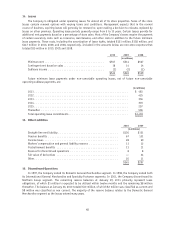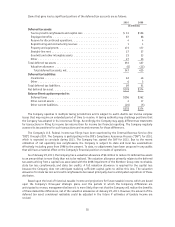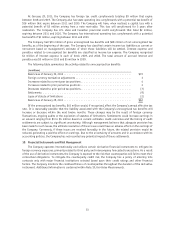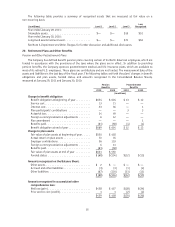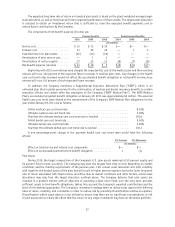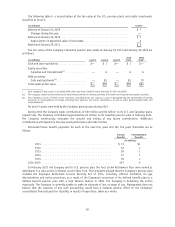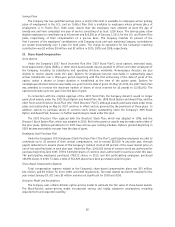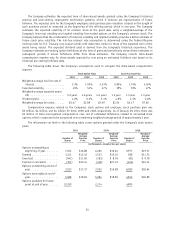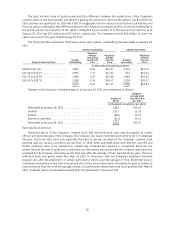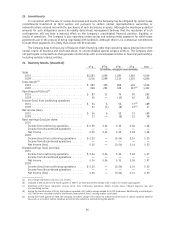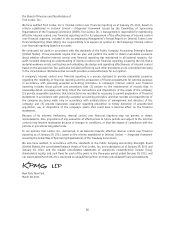Foot Locker 2010 Annual Report Download - page 77
Download and view the complete annual report
Please find page 77 of the 2010 Foot Locker annual report below. You can navigate through the pages in the report by either clicking on the pages listed below, or by using the keyword search tool below to find specific information within the annual report.
The target composition of the Company’s Canadian plan assets is 95 percent debt securities and 5 percent
equity. The Company believes that plan assets are invested in a prudent manner with the same overall objective
and investment strategy as noted above for the U.S. pension plan. The bond portfolio is comprised of government
and corporate bonds chosen to match the duration of the pension plan’s benefit payment obligations. This
current asset allocation will limit future volatility with regard to the funded status of the plan. This allocation
has resulted in higher pension expense due to the lower long-term rate of return associated with fixed-income
securities.
Valuation of Investments
Significant portions of plan assets are invested in commingled trust funds. These funds are valued at the net
asset value of units held by the plan at year end. Stocks traded on U.S. security exchanges are valued at closing
market prices on the measurement date.
Investments in real estate are carried at their estimated fair value based on information supplied by
independent appraisers whereby each property is independently appraised and adjusted accordingly at least once
within a five-year period. The Company’s management reviews the fair value of each property during the
intervening years to determine whether an impairment has occurred since receiving the latest independent
appraisal and that no change is required to the fair value.
The fair values of the Company’s U.S. pension plan assets at January 29, 2011 and January 30, 2010 are as
follows:
(in millions) Level 1 Level 2 Level 3 2010
Total 2009
Total*
Cash and cash equivalents ................ $— $ 4 $— $ 4 $ 5
Equity securities:
U.S. large-cap
(1)
..................... — 137 — 137 110
U.S. mid-cap
(1)
...................... — 40 — 40 36
International
(2)
..................... — 70 — 70 62
Corporate stock
(3)
.................... 7 — — 7 17
Fixed income securities:
Long duration corporate and government
bonds
(4)
........................ — 214 — 214 200
Intermediate duration corporate and
government bonds
(5)
................ — 29 — 29 27
Other types of investments:
Real estate ........................ — — 9 9 7
Insurance contracts .................. — 1 — 1 1
Total assets at fair value ................. $ 7 $495 $ 9 $511 $465
* Each category of plan assets is classified within the same level of the fair value hierarchy for 2010 and 2009.
(1) These categories consist of various managed funds that invest primarily in common stocks, as well as other equity securities and a
combination of other funds.
(2) This category comprises two managed funds that invest primarily in international common stocks, as well as other equity securities and
a combination of other funds.
(3) This category consists of common and preferred stock, including $7 million and $4 million invested in the Company’s common stock for
2010 and 2009, respectively.
(4) This category consists of various fixed income funds that invest primarily in long-term bonds, as well as a combination of other funds,
that together are designed to exceed the performance of related long-term market indices.
(5) This category consists of a fixed income fund that invests primarily in intermediate duration bonds, as well as a combination of other
funds, that together are designed to track the performance of the Barclays Capital U.S. Intermediate Credit Index.
58


